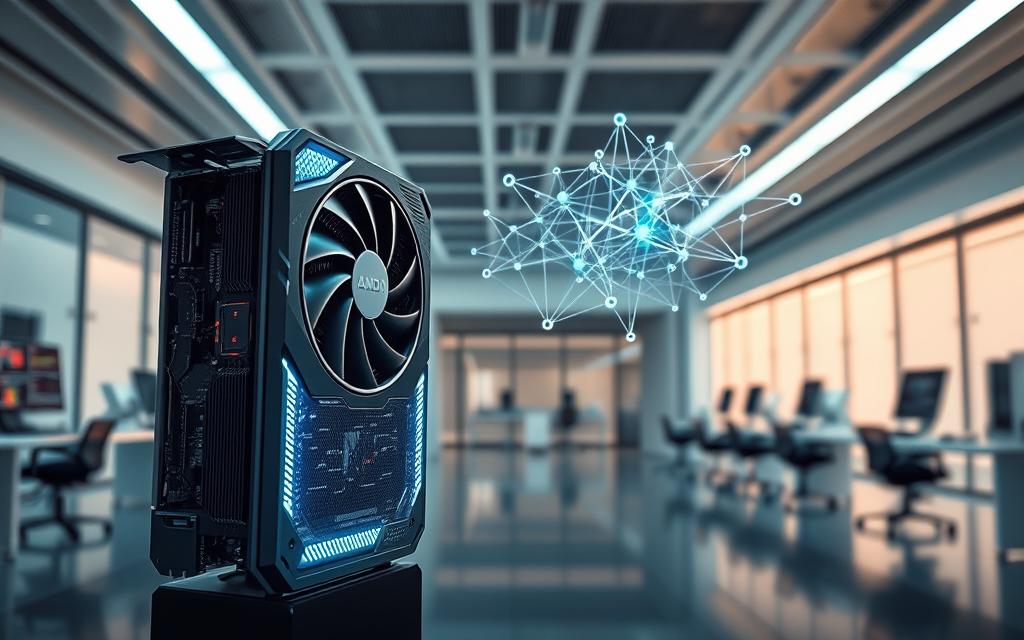In recent years, AMD has emerged as a strong contender in the field of machine learning. Their Radeon GPUs offer a cost-effective alternative to other hardware, making them a popular choice for developers. With advancements in technology, these GPUs now deliver impressive performance for AI-driven tasks.
One of the standout features of AMD GPUs is their VRAM capacity. This is crucial for handling modern AI models, which require significant memory resources. Additionally, these GPUs are compatible with popular frameworks like PyTorch, ensuring seamless integration into existing workflows.
For developers on a budget, AMD provides a compelling option. Their hardware offers a balance of affordability and efficiency, making it ideal for long training sessions. Real-world benchmarks highlight their capability to handle complex deep learning tasks effectively.
Introduction to AMD GPUs in Deep Learning
AMD’s hardware has gained traction in AI-driven applications due to its cost efficiency. The RX 6700 XT, for example, offers 12GB of VRAM at a competitive price point. This makes it an attractive option for developers balancing performance and affordability.
Why Choose AMD GPUs for Deep Learning?
One of the standout features is the VRAM capacity. Compared to similar hardware, AMD GPUs often provide 50% more memory. This is crucial for handling large datasets and complex models. Additionally, the cost of ownership is lower, making it ideal for hybrid use cases like gaming and machine learning.
Real-world benchmarks show that these GPUs deliver consistent results. Users report a 15-month ownership cost analysis that justifies the investment. The growing software ecosystem, including support for frameworks like PyTorch, further enhances their appeal.
Challenges and Opportunities
While AMD GPUs offer significant advantages, there are some problems to consider. The ROCm platform, for instance, can have compatibility issues with Mesa drivers. This contrasts with the plug-and-play setup of competing solutions.
However, the community has stepped up to address these challenges. Open-source projects like automatic1111 and Oobabooga are expanding support for AMD hardware. These efforts highlight the potential for future growth in the machine learning space.
“The balance of affordability and performance makes AMD GPUs a compelling choice for developers.”
As the ecosystem evolves, these GPUs are becoming a viable alternative for AI workloads. The combination of performance, cost, and community-driven solutions positions them as a strong contender in the field.
Understanding AMD GPU Architecture
The RDNA 2 architecture brings significant improvements for modern workloads. It is designed to handle complex computations efficiently, making it a strong choice for AI-driven tasks. This architecture focuses on enhancing performance while maintaining power efficiency.
Key Features of AMD GPUs
One of the standout features is the Compute Unit structure. These units are optimized for parallel processing, enabling faster data handling. Stream Processors, which are equivalent to CUDA cores, play a crucial role in this setup.
Memory bandwidth is another advantage. AMD GPUs excel in processing large datasets, thanks to their high memory throughput. This is particularly useful for applications requiring extensive data analysis.
The ROCm platform, built on OpenCL, provides a flexible foundation for developers. While it may not be as mature as CUDA, it offers a way to leverage AMD hardware effectively. FP16 and FP32 performance metrics also highlight the capabilities of these GPUs.
Comparison with Nvidia GPUs
When comparing AMD and Nvidia GPUs, several factors come into play. The PCIe 4.0 implementation in AMD hardware ensures faster data throughput, which is critical for machine learning tasks. Power efficiency under sustained loads is another area where AMD shines.
Multi-GPU scaling capabilities are also worth noting. AMD GPUs can handle a number of parallel tasks efficiently, making them suitable for large-scale applications. However, the driver stack maturity of Nvidia GPUs remains a key advantage.
“AMD’s architecture offers a balance of performance and efficiency, making it a viable alternative for modern workloads.”
In summary, AMD GPUs provide a compelling option for developers. Their architecture, combined with cost efficiency, positions them as a strong contender in the field of machine learning.
Setting Up Your AMD GPU for Deep Learning
Getting started with AI workloads requires proper hardware and software setup. Ensuring your system meets the necessary specifications is the first step toward seamless performance. This section covers everything from hardware requirements to driver installation.
Hardware Requirements
Modern AI models demand significant resources. A minimum of 12GB VRAM is recommended for handling large language models (LLMs). Ensure your machine has a PCIe 4.0 slot for optimal data throughput.
Power supply is another critical factor. High-performance GPUs require adequate wattage to function efficiently. Check your PSU specifications to avoid bottlenecks during intensive tasks.
Installing Drivers and Software
ROCm 5.6+ is essential for compatibility with tools like text-generation-webui. However, conflicts may arise with Mesa drivers, especially on newer ROCm versions. A dual-boot setup can help mitigate these issues.
Linux offers better support for AMD GPUs compared to Windows. Follow the step-by-step ROCm installation guide to ensure all dependencies are resolved. Diagnostic tools can verify hardware functionality post-installation.
Driver rollback procedures are useful if compatibility issues persist. Always keep a backup of stable driver software to maintain system integrity.
Installing ROCm for AMD GPUs
ROCm installation is a critical step for leveraging AMD hardware in AI workflows. Proper setup ensures compatibility with advanced machine learning frameworks and unlocks the full potential of your system. This guide covers the process and addresses common challenges.
Step-by-Step Installation Guide
Begin by choosing between Debian packages and source compilation. Debian packages offer a quicker way to get started, while source compilation provides greater customization. Ensure your kernel version matches the ROCm release to avoid mismatches.
Edit the one_click.py file to include the HSA_OVERRIDE_GFX_VERSION and HCC_AMDGPU_TARGET environment variables. This step is crucial for ensuring proper hardware recognition. Follow the official documentation for detailed instructions.
If you encounter Mesa library conflicts, consider a dual-boot setup or driver rollback. Version pinning strategies can help maintain stability by preventing unwanted updates. Always verify dependencies to avoid broken installations.
Common Installation Issues and Fixes
Kernel version mismatches are a frequent issue. Ensure your system meets the minimum requirements before proceeding. Debugging installation logs can provide insights into unresolved dependencies or conflicts.
For unsupported GPU architectures, community patches are often available. These patches enable compatibility with older or less common hardware. Engage with forums and support channels for additional assistance.
Recovery from broken dependencies requires careful attention. Keep backups of stable driver libraries and follow step-by-step recovery procedures. Community-driven solutions often provide the best way to resolve complex issues.
“Proper ROCm setup ensures seamless integration with AI tools, making it a cornerstone of AMD’s machine learning ecosystem.”
By following these steps and addressing common challenges, you can optimize your system for AI workloads. The end result is a stable, high-performance environment tailored to your needs.
Configuring Your Deep Learning Environment
Creating an efficient environment for AI tasks starts with proper configuration. This ensures seamless integration of tools and frameworks, enabling smooth workflows. A well-structured setup minimizes errors and maximizes performance.
Setting Up Python and Libraries
Python is the backbone of most machine learning applications. Begin by installing the latest version compatible with your system. Use ROCm-enabled PyTorch for optimal hardware utilization.
Libraries like NumPy, Pandas, and TensorFlow are essential. Ensure they are installed correctly to avoid compatibility issues. Version locking critical packages helps maintain stability over time.
Using Virtual Environments
Virtual environments isolate dependencies, preventing conflicts between projects. Conda is a popular choice for managing these environments. It simplifies package installation and ensures reproducibility.
Automated environment replication saves time when deploying across multiple machines. Tools like Docker can further streamline this process. Cross-framework compatibility checks ensure smooth transitions between different workflows.
| Python Build | Performance | Compatibility |
|---|---|---|
| Standard | High | Wide |
| Optimized | Very High | Limited |
| Custom | Variable | Custom |
Benchmarking different Python builds helps identify the best fit for your machine. GPU utilization monitoring tools provide insights into performance. These steps ensure your environment is optimized for AI tasks.
Optimizing Performance on AMD GPUs
Efficiently managing resources is key to unlocking the full potential of modern hardware. By focusing on strategies to enhance performance, you can achieve faster and more reliable results. This section explores practical tips to maximize GPU utilization and reduce memory overhead.
Tips for Maximizing GPU Utilization
Batch size optimization is a critical step. Adjusting the batch size ensures that your models process data efficiently without overloading the system. Mixed precision training further enhances performance by reducing computational demands.
Kernel auto-tuning techniques allow the engine to adapt to specific workloads. This ensures smoother operations and minimizes bottlenecks. Monitoring VRAM allocation helps identify potential issues early, ensuring stable performance during long sessions.
Reducing Memory Overhead
Model quantization is an effective way to reduce memory usage. By simplifying data structures, you can handle larger datasets without compromising speed. Cooling system considerations are also essential. Proper cooling prevents thermal throttling, maintaining consistent power output.
Power limit adjustments can help balance energy consumption and performance. Detecting memory leaks early ensures that resources are used efficiently. These things collectively contribute to a more streamlined workflow.
| Strategy | Impact | Implementation |
|---|---|---|
| Batch Size Optimization | High | Manual or Automated |
| Mixed Precision Training | Very High | Framework-Specific |
| Model Quantization | Moderate | Custom Scripts |
By implementing these strategies, you can optimize your system for AI-driven tasks. The result is a more efficient and cost-effective workflow, with 2000 image generations costing as little as $0.10. Efficient resource management ensures that your hardware operates at peak performance.
Deep Learning Frameworks Compatible with AMD GPUs
Modern AI development relies heavily on compatible frameworks to maximize hardware potential. AMD GPUs, with their growing ecosystem, now support a variety of popular tools. This ensures seamless integration for developers working on advanced applications.
TensorFlow and PyTorch on AMD
TensorFlow and PyTorch are two of the most widely used frameworks in machine learning. ROCm-enabled TensorFlow builds allow developers to leverage AMD hardware efficiently. PyTorch, with its DirectML integration, offers another robust way to utilize these GPUs.
Custom kernel development further enhances performance. Community-maintained forks often include optimizations tailored for specific models. These efforts ensure that AMD GPUs remain competitive in the AI space.
Other Supported Frameworks
Beyond TensorFlow and PyTorch, several other frameworks are compatible with AMD hardware. ONNX Runtime provides excellent performance for inference tasks. MXNet, though less commonly used, also offers ROCm support.
- Keras backend configuration simplifies setup for beginners.
- Framework-specific optimizations improve efficiency for complex tasks.
- Community-driven projects like ExLlamaV2_HF loader expand compatibility.
These tools collectively provide a versatile environment for AI development. Whether you’re working on a research paper or a production-grade application, AMD GPUs offer the flexibility needed to succeed.
Running Stable Diffusion on AMD GPUs
Stable Diffusion has become a popular tool for generating high-quality images, and AMD hardware offers a reliable platform for running it. With the right setup, users can achieve impressive results while optimizing performance. This section covers the essential steps for configuration and highlights key benchmarks.
Setup and Configuration
Customizing the Automatic1111 webui is a critical first step. This interface allows users to fine-tune settings for better compatibility with AMD hardware. Checkpoint compatibility issues may arise, but these can often be resolved by updating to the latest version of the software.
LoRA training configurations are another important consideration. These settings enable users to adapt models for specific tasks, improving output quality. Proper VRAM allocation ensures smooth operation, especially when working with higher resolutions.
Performance Benchmarks
Batch generation optimization is key to reducing processing time. For example, generating 96 images typically takes 10-15 minutes on a well-configured computer. Sampler performance comparisons reveal that certain algorithms deliver faster results without compromising quality.
Upscaling pipeline integration further enhances output resolution. However, users must balance output quality with speed to achieve the best results. The table below summarizes key performance metrics for different configurations.
| Configuration | Image Quality | Processing Time |
|---|---|---|
| Default Settings | High | 15 minutes |
| Optimized Batch Size | Very High | 10 minutes |
| Upscaling Enabled | Ultra High | 20 minutes |
By implementing these strategies, users can maximize the potential of their AMD hardware. The combination of proper setup and performance optimization ensures a seamless experience for generating high-quality images.
Using Oobabooga’s Text-Generation-WebUI
Oobabooga’s Text-Generation-WebUI has become a go-to tool for developers working with advanced language models. This intuitive interface simplifies the process of running and managing complex text generation tasks. With support for AMD hardware, it offers a seamless experience for users looking to optimize their workflows.
Installation and Setup
Setting up the Text-Generation-WebUI involves configuring the environment variables for optimal performance. For AMD GPUs like the 6700 XT, the gfx1030 target is essential. This ensures compatibility and maximizes hardware utilization.
Follow the official documentation to install dependencies and resolve any conflicts. A step-by-step guide simplifies the process, making it accessible even for beginners. Proper setup ensures smooth operation and reduces potential errors.
Running Models on AMD GPUs
Once installed, running models on AMD GPUs is straightforward. The WebUI supports various quantization formats, including GGUF and GPTQ. These formats allow users to balance performance and memory usage effectively.
- Optimize the context window for better text generation.
- Integrate LoRA adapters for specialized tasks.
- Use custom character templates for personalized outputs.
- Configure API endpoints for external applications.
- Leverage performance profiling tools to monitor efficiency.
- Switch between multiple models seamlessly.
“The Text-Generation-WebUI provides a flexible and efficient way to handle advanced language models, making it a valuable tool for developers.”
With each release, Oobabooga’s WebUI continues to improve, offering new features and better compatibility. This makes it an essential tool for anyone working with language models on AMD hardware.
Training Models on AMD GPUs
Training AI models efficiently requires a blend of strategy and technical know-how. Proper planning ensures that resources are used effectively, leading to faster and more accurate results. This section explores best practices and techniques for handling large datasets during the training process.
Best Practices for Training
Dataset preprocessing pipelines are essential for preparing data efficiently. Cleaning and normalizing data beforehand reduces errors during training. Checkpoint frequency optimization ensures that progress is saved regularly, preventing loss of work in case of interruptions.
Hyperparameter tuning approaches help fine-tune the model for better performance. Overfitting prevention techniques, such as dropout layers, ensure that the model generalizes well to new data. These strategies collectively enhance the training process, making it more efficient and reliable.
Handling Large Datasets
Memory-mapped file strategies allow efficient access to large datasets without overloading system memory. Distributed training configurations enable parallel processing, reducing the time required for complex tasks. These methods are particularly useful for applications involving massive amounts of data.
- Optimize batch sizes for faster processing.
- Use loss function customization to improve accuracy.
- Implement recovery mechanisms for interrupted training sessions.
| Strategy | Impact | Implementation |
|---|---|---|
| Dataset Preprocessing | High | Automated Pipelines |
| Checkpoint Optimization | Moderate | Manual Configuration |
| Hyperparameter Tuning | Very High | Grid Search |
By following these best practices, developers can maximize the potential of their hardware. Efficient training not only saves time but also improves the quality of the final model. These techniques are essential for achieving success in AI-driven applications.
Inference on AMD GPUs
Inference tasks are a critical component of AI workflows, requiring both speed and accuracy. Optimizing these processes ensures that AI systems deliver real-time results efficiently. This section explores strategies to enhance performance and compares AMD GPUs with competing solutions.
Speed and Efficiency
Quantization plays a significant role in improving inference speed. By reducing the precision of calculations, models can process data faster without sacrificing accuracy. Batch inference optimization further enhances time efficiency by handling multiple inputs simultaneously.
Kernel fusion techniques streamline operations, reducing overhead and improving engine performance. API response latency reduction is another key factor, ensuring that applications remain responsive under heavy workloads. These strategies collectively contribute to faster and more reliable inference.
Comparing Inference Times with Nvidia
When comparing AMD and Nvidia GPUs, inference time is a critical metric. For example, Mistral 7B achieves a 90-second inference time on AMD hardware, while ChatGPT API latency may vary. Precision mode comparisons reveal that AMD GPUs often deliver competitive results in FP16 and FP32 modes.
- Concurrent request handling improves throughput for high-demand applications.
- Energy consumption metrics highlight the efficiency of AMD GPUs under sustained loads.
- Real-time application limits are tested to ensure compatibility with dynamic workloads.
“Optimizing inference processes ensures that AI systems remain scalable and efficient, meeting the demands of modern applications.”
By focusing on these strategies, developers can maximize the potential of their hardware. The result is a seamless experience for users, with faster and more accurate AI-driven solutions.
Cost Efficiency of AMD GPUs in Deep Learning
Balancing cost and performance is a key consideration for AI developers. AMD hardware offers a compelling solution, delivering high efficiency without breaking the budget. This section explores the financial benefits of using these GPUs for machine learning tasks.
Cost vs. Performance Analysis
When evaluating hardware, the cost-to-performance ratio is critical. AMD GPUs provide significant memory capacity at a lower price point compared to competitors. For example, generating 2000 images can cost as little as $0.10 in electricity over four hours of continuous use.
Energy power efficiency is another advantage. These GPUs consume less energy during intensive training sessions, reducing operational expenses. Developers can achieve faster results without compromising on quality or increasing overhead.
Long-Term Savings
Investing in AMD hardware ensures long-term financial benefits. Total ownership cost calculations include factors like hardware depreciation, maintenance, and resale value retention. These GPUs retain their value well, making them a smart choice for budget-conscious developers.
- Cloud vs. local cost comparisons highlight savings over time.
- Scalability projections ensure flexibility for growing projects.
- Energy efficiency metrics reduce recurring expenses.
“AMD GPUs strike a balance between affordability and performance, making them ideal for developers focused on long-term savings.”
By optimizing power usage and minimizing hardware costs, developers can allocate resources more effectively. This approach ensures sustainable growth for AI-driven models and data-intensive applications.
Common Problems and Solutions
Addressing technical challenges is essential for maximizing hardware performance. Developers often face issues that can disrupt workflows, but understanding these problems and their solutions ensures smoother operations. This section covers common errors and the resources available to resolve them.
Debugging Common Errors
One of the most frequent problems is ROCm installation failure. Diagnosing this involves checking kernel versions and ensuring compatibility with the hardware. Downgrading package versions can often resolve mismatches and restore functionality.
Memory allocation errors are another hurdle. These occur when the system struggles to handle large datasets. Optimizing VRAM usage and adjusting batch sizes can mitigate these things. Kernel timeouts, often caused by driver conflicts, require careful driver signature verification and updates.
CUDA compatibility layer issues can also arise. While AMD hardware doesn’t natively support CUDA, community-driven solutions like ROCm provide alternatives. Debugging these errors involves checking environment variables and ensuring proper library installations.
Community Support and Resources
When facing technical challenges, leveraging community support can be invaluable. Platforms like Discord and GitHub offer active forums where developers share fixes and workarounds. Tracking issues on GitHub helps identify common problems and their resolutions.
Documentation gaps can sometimes complicate troubleshooting. However, community-driven projects often fill these voids with detailed guides and tutorials. Engaging with these resources ensures that developers can find solutions efficiently.
“The community’s collective knowledge is a powerful tool for overcoming technical hurdles and achieving seamless performance.”
By utilizing these resources, developers can address errors effectively and reach the end goal of a stable, high-performing system. Collaboration and shared expertise make it easier to navigate complex challenges in AI development.
Future of AMD GPUs in Deep Learning
The landscape of AI hardware is rapidly evolving, and AMD is positioning itself as a key player in the future of machine learning. With advancements like the MI300X featuring 192GB of HBM3 memory, AMD is pushing the boundaries of what’s possible in AI applications. This hardware is designed to handle the most demanding workloads, offering a glimpse into the future of high-performance computing.
AMD’s roadmap for AI and machine learning includes significant developments in the CDNA architecture. These improvements aim to enhance compute performance and efficiency, making it easier to train complex models. The Radeon ML SDK, with support for DirectML and Metal, further expands the ecosystem, providing developers with more tools to innovate.
Upcoming Features and Updates
ROCm 6.0 is set to introduce new features that streamline AI workflows. HIP-RT ray tracing integration and AI accelerator hardware are among the highlights. These updates promise to improve both training and inference tasks, making AMD GPUs more versatile for a wide range of applications.
- Enterprise-grade solutions for large-scale deployments.
- Cloud partnership expansions to enhance accessibility.
- Open ecosystem initiatives to foster collaboration.
These advancements are not just about hardware but also about creating a robust software environment. AMD’s focus on open ecosystems ensures that developers have the flexibility to innovate without constraints.
AMD’s Roadmap for AI and Machine Learning
AMD’s long-term vision includes integrating AI capabilities into everyday computing. The MI300X, for instance, is a testament to this commitment. With its massive memory capacity, it’s ideal for handling large datasets and complex models. This aligns with AMD’s goal of making AI more accessible and efficient.
“AMD’s focus on innovation and open ecosystems ensures that developers have the tools they need to push the boundaries of AI.”
Research paper implementations and community-driven projects are also part of AMD’s strategy. By collaborating with academic institutions and industry leaders, AMD is paving the way for future breakthroughs in machine learning.
For more insights into AMD’s advancements, check out this detailed analysis.
Case Studies: Success Stories with AMD GPUs
Exploring real-world implementations reveals the versatility of AMD hardware. From academic research to content creation, these GPUs have proven their worth in diverse applications. This section dives into specific success stories and the lessons learned along the way.
Real-World Applications
One notable case is the integration of AMD GPUs with DaVinci Resolve Studio. This setup enables seamless speech-to-text functionality, streamlining post-production workflows. The data processing capabilities of AMD hardware ensure accurate and efficient transcription, even for large files.
Another example is the use of AMD GPUs in Stable Diffusion workflow automation. Developers have leveraged these GPUs to generate high-quality images at scale. The model optimization techniques employed ensure consistent performance, even under heavy workloads.
Lessons Learned
Several key insights have emerged from these implementations. First, proper hardware configuration is essential for maximizing performance. Second, community-driven solutions often address compatibility issues effectively. These things highlight the importance of adaptability in AI-driven projects.
Failed project post-mortems also provide valuable lessons. For instance, inadequate VRAM allocation can lead to bottlenecks. Addressing these challenges early ensures smoother workflows and better results.
| Application | Key Benefit | Challenge |
|---|---|---|
| DaVinci Resolve Studio | Efficient speech-to-text | Large file handling |
| Stable Diffusion | High-quality image generation | VRAM optimization |
By examining these case studies, developers can gain actionable insights for their own projects. The combination of real-world applications and lessons learned underscores the potential of AMD GPUs in modern AI workflows.
Conclusion
The growing ecosystem for machine learning continues to evolve, offering developers powerful tools and cost-effective solutions. AMD’s hardware and software synergy provides a strong foundation for both entry-level and professional use cases. With a focus on performance and affordability, these solutions ensure long-term value for developers.
Total cost of ownership remains a key advantage, making it an attractive choice for those balancing budgets and efficiency. The developer community has also grown significantly, contributing to a robust ecosystem that supports innovation and collaboration.
Looking ahead, future-proofing considerations ensure that these tools remain relevant as machine learning advances. By engaging with the community and leveraging the latest updates, developers can stay ahead in this dynamic field. The end goal is to create a seamless way to integrate hardware and software for optimal results.



















